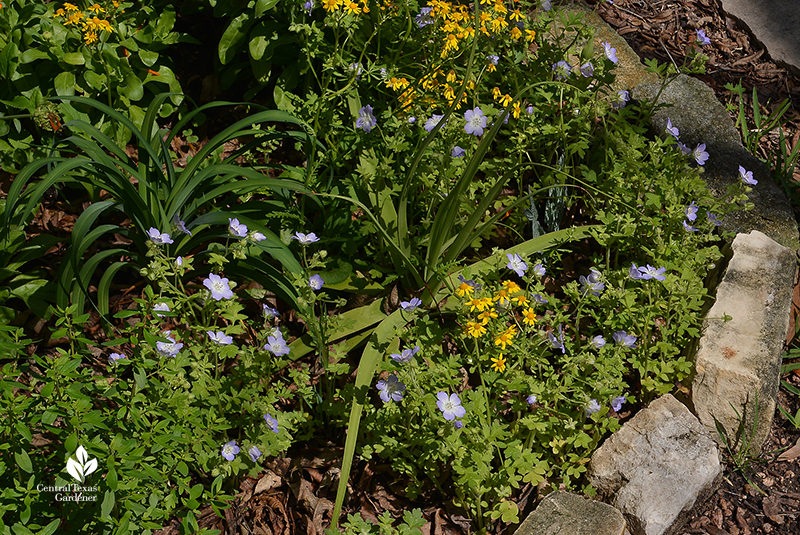March 24, 2021
Company’s Coming!
I had lots of company last Sunday. They zoomed around faster than my speeding pruners as whack-back 2021 carried on. I finally dropped the gloves for the camera just in time to catch a metallic sweat bee nuzzling native wildflower baby blue eyes.

One spring in a shady spot at Zilker Botanical Garden, I fell in love with baby blue eyes, hugging the ground with soft blue blossoms against sunshine yellow columbines. So, I did it! This spot in my garden gets morning sun only, but this picture is from my archives. Since then, the columbines have disappeared, as they sometimes do.

A friend got me started with baby blue eyes years ago with transplants she divided from her brood. These native annuals (Nemophila menziesii) generously self-seed, forming rosettes in late fall. March signals bloom time. These seeded near evergreen oregano.

Many wildflowers want as much sun as they can get, but baby blue eyes tucks into part shade to part sun spots. For a few years, they colonized around native golden groundsel (Packera obovata), squid agave (Agave braceteosa), and ‘Orange Crush’ daylily.


For some reason, they’ve ducked out of that bed (for now). Evergreen, perennial golden groundsel now dominates all year. A fiery skipper butterfly joined the feeding frenzy this week.

Tiny pollinators dodged all around. I can’t say for sure, but this may be a black hoverfly, a garden friend you want to attract. Its larvae prey on aphids, scale, thrips, and caterpillars.

There are many native spiderworts, but we’ve got Tradescantia gigantea. Since they cross pollinate and seed to compatible locations, it’s always fun to see what colors pop up in new spots. This year, I lucked into a dreamy duo of magenta-hued against groundsel’s golden.

For years, they’ve populated our part shade spots since we rescued a handful from razing. Easily divided, I plunked a few under this tree where they’ve multiplied to join pink oxalis. It’s a combo perfect for bee-friendly fast-food orders.

This one tucked against Mexican feather grass that got its spring clip last weekend.

Most of my plants have made it back, though some are slow to return, awaiting warmer weather. Already, annual sunflowers (spread by the birds) are up in my garden and at Este Garden @este.gardenatx, the renewed gardens at the former East Side Café gardens (more about them soon). At Este, they’ll help shade the newly planted tomatoes this summer.

So, it was a kick to note that the Lady Bird Johnson Wildflower Center has honored sunflowers as their first Wildflower of the Year!

There are more than 80 native species that include the common annual and perennial fall standout, Maximilian sunflower.

Find native plants of all kinds at the Wildflower Center’s Spring Plant Sale—once again with extended days.
Friday – Sunday: April 2 – May 30
Members Only: 9 a.m. – 11 a.m.
Open to All: 11 a.m. – 1 p.m.
Reservations and masks required
Next week, environmental designer John Hart Asher suggests native clumping grasses to add to your list. See you then, and thanks for stopping by! Linda
tags:

